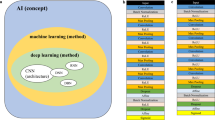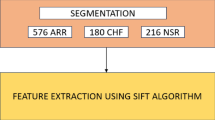Abstract
Identifying and accurately classifying cardiac abnormalities, including myocardial infarction (MI) and cardiac arrhythmia (CA), remains a significant challenge in the field of cardiology, largely due to the limitations inherent in traditional ECG signal analysis techniques. This paper presents an innovative method aimed at addressing this challenge. By implementing a novel transformation technique, we map temporal, frequency-based, statistical, and spatial features of ECG signals onto the R, G, and B channels of an RGB image. This conversion process results in a feature-rich representation of the ECG signal, significantly enhancing its clinical relevance and thus maximizing classification accuracy. Utilizing an adaptive RGB-ResNet inception architecture, our approach achieves remarkable average accuracies of 99.25% for myocardial infarction and 99.21% for cardiac arrhythmia. These figures underscore the robustness of our method and highlight its significant potential to advance cardiology diagnostics through the application of advanced image analysis techniques.








Similar content being viewed by others
Data Availability
The data generated during and/or analyzed during the current study are available from the corresponding author on reasonable request.
References
Ebrahimi Z, Loni M, Daneshtalab M, Gharehbaghi A (2020) A review on deep learning methods for ecg arrhythmia classification. Expert Syst Appl X 7:100033
Xiong P, Lee SM-Y, Chan G (2022) Deep learning for detecting and locating myocardial infarction by electrocardiogram: A literature review. Front Cardiovasc Med 9:860032
Ansari Y, Mourad O, Qaraqe K, Serpedin E (2023) Deep learning for ecg arrhythmia detection and classification: an overview of progress for period 2017–2023. Front Physiol 14
Kuila S, Dhanda N, Joardar S (2022) Ecg signal classification and arrhythmia detection using elm-rnn. Multimed Tools Appl 81(18):25233–25249
Hammad M, Abd El-Latif AA, Hussain A, Abd El-Samie FE, Gupta BB, Ugail H, Sedik A (2022) Deep learning models for arrhythmia detection in iot healthcare applications. Comput Electr Eng 100:108011
Tao R, Wang L, Xiong Y, Zeng Y-R (2024) Im-ecg: An interpretable framework for arrhythmia detection using multi-lead ecg. Expert Syst Appl 237:121497
Shamaee Z, Mivehchy M (2023) Dominant noise-aided emd (demd): Extending empirical mode decomposition for noise reduction by incorporating dominant noise and deep classification. Biomed Signal Process Control 80:104218
Li Y, Luo J-h, Dai Q-y, Eshraghian JK, Ling BW-K, Zheng C-y, Wang X-l (2023) A deep learning approach to cardiovascular disease classification using empirical mode decomposition for ecg feature extraction. Biomed Signal Process Control 79:104188
Pan W, An Y, Guan Y, Wang J (2022) Mca-net: A multi-task channel attention network for myocardial infarction detection and location using 12-lead ecgs. Comput Biol Med 150:106199
Yu J, Gao J, Wang N, Feng P, Zhou B, Wang Z (2023) Spa-tem mi: A spatial-temporal network for detecting and locating myocardial infarction. IEEE Trans Instrum Meas
Mewada H (2023) 2d-wavelet encoded deep cnn for image-based ecg classification. Multimed Tools Appl 1–17
Koresh H (2024) Impact of the preprocessing steps in deep learning-based image classifications. Natl Acad Sci Lett 1:1–3
Singhal S, Kumar M (2024) Gsmd-srst: Group sparse mode decomposition and superlet transform based technique for multi-level classification of cardiac arrhythmia. IEEE Sens J
Wu W, Huang Y, Wu X (2024) Srt: Improved transformer-based model for classification of 2d heartbeat images. Biomed Signal Process Control 88:105017
Zhang P, Ma C, Sun Y, Fan G, Song F, Feng Y, Zhang G (2021) Global hybrid multi-scale convolutional network for accurate and robust detection of atrial fibrillation using single-lead ecg recordings. Comput Biol Med 139:104880
Prabhakararao E, Dandapat S (2021) Multi-scale convolutional neural network ensemble for multi-class arrhythmia classification. IEEE J Biomed Health Inform 26(8):3802–3812
Jahmunah V, Ng EYK, Tan R-S, Oh SL, Acharya UR (2022) Explainable detection of myocardial infarction using deep learning models with grad-cam technique on ecg signals. Comput Biol Med 146:105550
Balık MY, Gökçe K, Atmaca S, Aslanger E, Güler A, Öksüz İ (2023) Interpretable deep learning for myocardial infarction detection from ecg signals. In: 2023 31st Signal processing and communications applications conference (SIU), pp 1–4. IEEE
Adib E, Fernandez AS, Afghah F, Prevost JJ (2023) Synthetic ecg signal generation using probabilistic diffusion models. IEEE Access
Nahak S, Pathak A, Saha G (2023) Evaluation of handcrafted features and learned representations for the classification of arrhythmia and congestive heart failure in ecg. Biomed Signal Process Control 79:104230
Murat F, Yildirim O, Talo M, Demir Y, Tan R-S, Ciaccio EJ, Acharya UR (2021) Exploring deep features and ecg attributes to detect cardiac rhythm classes. Knowl-Based Syst 232:107473
Khatar Z, Bentaleb D, Bouattane O (2024) Advanced detection of cardiac arrhythmias using a three-stage cbd filter and a multi-scale approach in a combined deep learning model. Biomed Signal Process Control 88:105551
Xiao Q, Lee K, Mokhtar SA, Ismail I, Pauzi ALbM, Zhang Q, Lim PY (2023) Deep learning-based ecg arrhythmia classification: A systematic review. Appl Sci 13(8):4964
Chen Z, Yang D, Cui T, Li D, Liu H, Yang Y, Zhang S, Yang S, Ren T-L (2024) A novel imbalanced dataset mitigation method and ecg classification model based on combined 1d_cbam-autoencoder and lightweight cnn model. Biomed Signal Process Control 87:105437
Narotamo H, Dias M, Santos R, Carreiro AV, Gamboa H, Silveira M (2024) Deep learning for ecg classification: A comparative study of 1d and 2d representations and multimodal fusion approaches. Biomed Signal Process Control 93:106141
Nawaz M, Saleem S, Masood M, Rashid J, Nazir T (2024) Covid-ecg-rsnet: Covid-19 classification from ecg images using swish-based improved resnet model. Biomed Signal Process Control 89:105801
Hammad AH, Abdulbaqi, AS (2024) 2d ecg classification system based on machine learning and lbp. In: AIP conference proceedings, vol 3009. AIP Publishing
Admass WS, Bogale GA (2024) Arrhythmia classification using ecg signal: A meta-heuristic improvement of optimal weighted feature integration and attention-based hybrid deep learning model. Biomed Signal Process Control 87:105565
Sheikh D, Verma H, Chauhan N (2024) Reduced lead ecg multi-label classification with higher generalization using 2d seresnets with self attention. Multimed Tools Appl 1–25
Sharma P, Dinkar SK (2024) An intelligent deep neural network with opposition based laplacian equilibrium optimizer to improve feature extraction using ecg signals. Biomed Signal Process Control 87:105415
Borra SR, Nayana DRGA, Srinidhi S, Bhavana S, Nishitha P, Sahithi V (2024) Cadnet: cardiac arrhythmia detection and classification using unified principal component analysis and 1d-cnn model. Res Biomed Eng 1–13
Wajgi R, Brammya G, Ramesh G, Deotare VV, Govindasamy C, Preetha NN (2024) A novel enhanced lemurs optimization-based hybrid attention network for classifying arrthymia from ecg signal using optimal weighted feature. Aust J Electr Electron Eng 1:1–25
Goldberger AL, Amaral LA, Glass L, Hausdorff JM, Ivanov PC, Mark RG, Mietus JE, Moody GB, Peng C-K, Stanley HE (2000) Physiobank, physiotoolkit, and physionet: components of a new research resource for complex physiologic signals. Circulation 101 23:215–220
Goldberger A, Amaral L, Glass L, Hausdorff J, Ivanov P, Mark R, Mietus J, Moody G, Peng C, Stanley H (2000) The MIT-BIH Arrhythmia Database. PhysioBank, MIT. https://physionet.org/content/mitdb/1.0.0/
Alotaibi B, Alotaibi M (2020) A hybrid deep resnet and inception model for hyperspectral image classification. PFG - J Photogramm Remote Sens Geoinf Sci 88(6):463–476
Szegedy C, Ioffe S, Vanhoucke V, Alemi A (2017) Inception-v4, inception-resnet and the impact of residual connections on learning. In: Proceedings of the AAAI conference on artificial intelligence, vol 31
Brown LD, Cai TT, DasGupta A (2001) Interval estimation for a binomial proportion. Stat Sci 16(2):101–133
Agresti A, Coull BA (1998) Approximate is better than “exact’’ for interval estimation of binomial proportions. Am Stat 52(2):119–126
Moghadam SR, Asl BM (2023) Automatic diagnosis and localization of myocardial infarction using morphological features of ecg signal. Biomed Signal Process Control 83:104671
Singh VM, Saran V, Kadambi P (2023) Autonomous myocardial infarction detection from electrocardiogram with a multi label classification approach. In: Asian conference on machine learning, pp 911–926. PMLR
Nagaraj J, Leema A (2023) Light weight multi-branch network-based extraction and classification of myocardial infarction from 12 lead electrocardiogram images. Imaging Sci J 71(2):188–198
Mandala S, Amini SS, Syaifullah AR, Pramudyo M, Nurmaini S, Abdullah AH et al (2023) Enhanced myocardial infarction identification in phonocardiogram signals using segmented feature extraction and transfer learning-based classification. IEEE Access 11:136654–136665
Sadad T, Safran M, Khan I, Alfarhood S, Khan R, Ashraf I (2023) Efficient classification of ecg images using a lightweight cnn with attention module and iot. Sensors 23(18):7697
Attallah O, Ragab DA (2023) Auto-myin: Automatic diagnosis of myocardial infarction via multiple glcms, cnns, and svms. Biomed Signal Process Control 80:104273
Aziz S, Khan MU, Iqtidar K, Sharma S, Montes GA, Gareeballah A (2023) Detection of myocardial infarction using spectral textures through ecg. In: 2023 International conference on communication, computing and digital systems (C-CODE), pp 1–6. IEEE
Mandala S, et al (2023) Myocardial infarction detection as an element of preventive medicine with random forest. In: 2023 International conference on advancement in data science, e-learning and information system (ICADEIS), pp 1–5. IEEE
Rawal V, Prajapati P, Darji A (2023) Hardware implementation of 1d-cnn architecture for ecg arrhythmia classification. Biomed Signal Process Control 85:104865
Kumar A, Kumar SA, Dutt V, Shitharth S, Tripathi E (2023) Iot based arrhythmia classification using the enhanced hunt optimization-based deep learning. Expert Syst 40(7):13298
Reddy SD, Murugan R, Nandi A, Goel T (2023) Classification of arrhythmia disease through electrocardiogram signals using sampling vector random forest classifier. Multimed Tools Appl 82(17):26797–26827
Serhal H, Abdallah N, Marion J-M, Chauvet P, Oueidat M, Humeau-Heurtier A (2023) An emd-based approach for atrial fibrillation classification using wavelets and convolutional neural network. Biomed Signal Process Control 82:104507
Pham B-T, Le PT, Tai T-C, Hsu Y-C, Li Y-H, Wang J-C (2023) Electrocardiogram heartbeat classification for arrhythmias and myocardial infarction. Sensors 23(6):2993
Zhang Y, Yi J, Chen A, Cheng L (2023) Cardiac arrhythmia classification by time-frequency features inputted to the designed convolutional neural networks. Biomed Signal Process Control 79:104224
Wang Y, Yang G, Li S, Li Y, He L, Liu D (2023) Arrhythmia classification algorithm based on multi-head self-attention mechanism. Biomed Signal Process Control 79:104206
Karri M, Annavarapu CSR, Pedapenki KK (2023) A real-time cardiac arrhythmia classification using hybrid combination of delta modulation, 1d-cnn and blended lstm. Neural Process Lett 55(2):1499–1526
Author information
Authors and Affiliations
Corresponding author
Ethics declarations
Competing interest
The authors declare that they have no known competing financial interests or personal relationships that could have appeared to influence the work reported in this paper.
Additional information
Publisher's Note
Springer Nature remains neutral with regard to jurisdictional claims in published maps and institutional affiliations.
Rights and permissions
Springer Nature or its licensor (e.g. a society or other partner) holds exclusive rights to this article under a publishing agreement with the author(s) or other rightsholder(s); author self-archiving of the accepted manuscript version of this article is solely governed by the terms of such publishing agreement and applicable law.
About this article
Cite this article
Khatar, Z., Bentaleb, D. Enhanced ECG Signal features transformation to RGB matrix imaging for advanced deep learning classification of myocardial infarction and cardiac arrhythmia. Multimed Tools Appl (2024). https://doi.org/10.1007/s11042-024-19352-z
Received:
Revised:
Accepted:
Published:
DOI: https://doi.org/10.1007/s11042-024-19352-z




